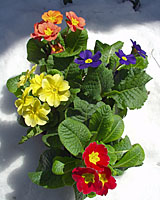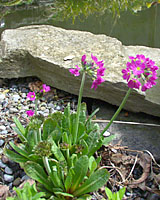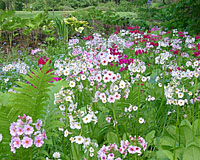Terry L. Ettinger Horticulture Consulting Services
Meeting The Needs Of Today With A Vision For The Future
Question of the Week
Primroses as Perennials
 Q. I bought six beautiful, multi-colored primroses at a local home improvement center in late February. They did
very well inside for about a month, but now they’re looking pretty droopy. Can they be planted outside and be expected to
come back next year? The name on the tag is ‘Danova Mix’ primrose.
Q. I bought six beautiful, multi-colored primroses at a local home improvement center in late February. They did
very well inside for about a month, but now they’re looking pretty droopy. Can they be planted outside and be expected to
come back next year? The name on the tag is ‘Danova Mix’ primrose.
A. It’s certainly hard to resist the temptation to pick up a few inexpensive pots of these brightly colored “Polyantha hybrid” primroses when they become available each February and March! And, the good news is that, yes, it is possible to transplant them into your garden and expect them to return year after year – providing you pay attention to their needs.
 As a rule, primroses do best when grown in cool, constantly moist and partially shaded sites, especially during the heat
of midsummer. And, even when given these conditions, it’s not unusual for them to go dormant and disappear from view in July
and August because of their intolerance of hot weather. Fortunately, if they’re happy where you’ve planted them, they’ll
send up a new rosette of crinkly leaves each autumn when cool, damp weather returns.
As a rule, primroses do best when grown in cool, constantly moist and partially shaded sites, especially during the heat
of midsummer. And, even when given these conditions, it’s not unusual for them to go dormant and disappear from view in July
and August because of their intolerance of hot weather. Fortunately, if they’re happy where you’ve planted them, they’ll
send up a new rosette of crinkly leaves each autumn when cool, damp weather returns.
 Other primroses that do well in Central New York providing that you meet their requirements include the April-blooming
common (Primula vulgaris) and drumstick (P. denticulata) primroses,
above left, that bloom in April in our garden. They’ll be followed by the
“candelabara” Japanese (P. japonica) and “Bees” (P. bulleyana x. P. beesiana) hybrids that bloom from May into June
along the edges of streams and ponds, at right.
Other primroses that do well in Central New York providing that you meet their requirements include the April-blooming
common (Primula vulgaris) and drumstick (P. denticulata) primroses,
above left, that bloom in April in our garden. They’ll be followed by the
“candelabara” Japanese (P. japonica) and “Bees” (P. bulleyana x. P. beesiana) hybrids that bloom from May into June
along the edges of streams and ponds, at right.
To learn more about growing primroses, visit the America Primrose Society website.